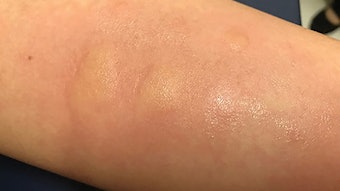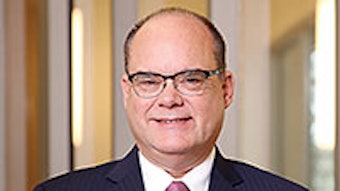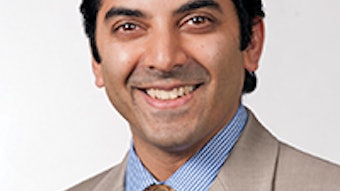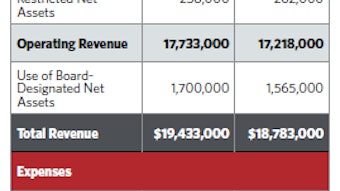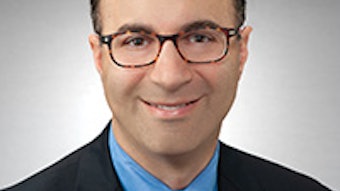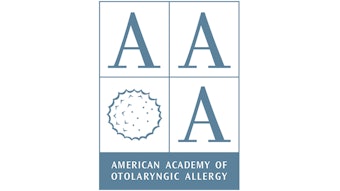June is National Dysphagia Month
Patients with throat discomfort are frequently seen in otolaryngology clinics, with population-based studies from the United States reporting 12.5% of otherwise healthy people reporting globus, reaching as high as 46% in some series. Distinguishing globus—first described by Hippocrates 2,500 years ago—from bona fide swallowing impairment can be challenging.
Ozlem Tulunay-Ugur, MD, and Derrick R. Randall, MD, MSc, FRCSC, for the AAO-HNS Airway and Swallowing Committee

Patients with throat discomfort are frequently seen in otolaryngology clinics, with population-based studies from the United States reporting 12.5% of otherwise healthy people reporting globus, reaching as high as 46% in some series.1-3 Distinguishing globus—first described by Hippocrates 2,500 years ago4—from bona fide swallowing impairment can be challenging. This is so not only due to myriad potential etiologies, but also because the degree of symptoms and impact on quality of life associated with different clinical conditions range widely.5-7 Notably, even those affected with a limited degree of dysphagia can still report appreciable impact on quality of life, and these effects of dysphagia extend to caregivers.8,9 Between otolaryngology and gastroenterology, consensus exists that globus has organic and functional causes. Nonetheless, it is considered a diagnosis of exclusion after evaluation of organic etiologies. Gastroesophageal reflux disease, laryngopharyngeal reflux, chronic irritation due to postnasal drainage, xerostomia, environmental dryness, esophageal motility disorders, and upper esophageal dysfunction have been implicated as causes of globus.10,11
The role of a thorough history-making is central to medicine, and separation of most patients with benign, functional complaints from problematic dysphagia by historical features is well established.12,13 Managing patients with severe swallowing impairment is relatively straightforward for most otolaryngologists, but the spectrum of diseases presenting with mild dysphagia or globus is extensive and presents potential difficulties. Balancing the need for further testing in a patient with globus sensation should be based on the potential for identification of an underlying process versus exposing patients to unnecessary risks; healthcare systems meanwhile must mitigate unnecessary demand and cost.
Patients who show no red flags such as odynophagia, weight loss, chest pain, lateralization of symptoms, or cough usually require no further testing once a laryngoscopy has been performed. In a large series of 451 patients with exclusive globus-type symptoms and no red flags, only six patients were noted to have an abnormality not detectable during standard office examination; if in-office esophagoscopy were incorporated into practice, then all causes could have been identified.14 A recent Finnish series recognized that no patients with typical globus symptoms, as well as an unremarkable history and examination, developed a malignancy over six years. Half the patients in this series had resolution of their symptoms with time and no specific intervention.15 Therefore, patients with mild symptoms largely benefit from reassurance alone.
Transnasal esophagoscopy (TNE) can be beneficial in this patient population in order to rule out pathologies such as gastric inlet patch or eosinophilic esophagitis, as recommended by the Rome IV diagnostic criteria. The literature is clear that TNE is well tolerated by patients, has a very low risk of complications, and is highly efficient for the surgeon.16 Luk et al. in their review of videofluoroscopic swallow studies (VFSS) of 908 globus patients reported 86% had normal results.17 Authors concluded that the examination has limited diagnostic value and therefore is not recommended for globus patients. Järvenpää et al. corroborated these findings and showed that VFSS had no benefit in globus diagnostics.15
For most patients with globus sensation, the management is a comprehensive explanation of findings and reassurance that there is no worrisome pathology nor need for further testing. On the other hand, practitioners frequently pursue trial of antireflux therapy in the management of globus pharyngeus.14 The treatment of acid reflux, an ever-evolving entity, is beyond the scope of this paper. Nonetheless, the management of reflux should include not only medication trial but also emphasis on necessary lifestyle measures. In patients who fail this trial or have partial response, further testing can be pursued. High-resolution manometry and pH-probe testing with impedance can be offered. It has been noted that patients with other accompanying symptoms of GERD or LPR, such as throat clearing or heartburn, respond better to antacid treatment and have higher rates of resolution of globus.14
In patients with findings of muscle tension on laryngoscopy, voice therapy should be offered. Wareing et al. reported improvement in 23 of 25 patients with complete resolution in 72% of cases.18 Similarly, in a randomized controlled trial comparing speech therapy with reassurance, Khalil et al. found significant improvement in globus symptom scores in the therapy group compared with reassurance only at three months.19
It has been noted that patients with globus sensation can have high prevalence of anxiety. Deary et al. reported that globus patients are significantly more depressed than controls.20 Cognitive behavioral therapy has been suggested by Burns et al. for patients with refractory symptoms, while Kiebles et al. reported successful use of hypnotically assisted relaxation therapy. There is also scant evidence to suggest antidepressants may be of benefit in select patients.21,22
In summary, globus is a benign condition that can cause patients significant distress. Our role is to differentiate these patients from patients with frank dysphagia and possible underlying pathologies. This is mainly established through good history taking and office laryngoscopy. Patients without findings on either can be reassured and spared from costly testing and potential risks of procedures.
References
- Drossman DA, Li Z, Andruzzi E, et al. U.S. householder survey of functional gastrointestinal disorders. Prevalence, sociodemography, and health impact. Dig Dis Sci. 1993;38:1569-1580.
- Thompson WG, Heaton KW. Heartburn and globus in apparently healthy people. Can Med Assoc J. 1982;126:46-48
- Tang B, Cai HD, Xie HL, Chen DY, Jiang SM, Jia L. Epidemiology of globus symptoms and associated psychological factors in China. J Dig Dis. 2016;17:319-324.
- Harar RP, Kumar S, Saeed MA, Gatland DJ. Management of globus pharyngeus: review of 699 cases. J Laryngol Otol. 2004;118:522–527.
- Alali D, Ballard K, Bogaardt H. The frequency of dysphagia and its impact on adults with multiple sclerosis based on patient-reported questionnaires. Mult Scler Relat Disord. 2018;25:227-231.
- Mohannak N, Pattison G, Hird K, Needham M. Dysphagia in patients with sporadic inclusion body myositis: management challenges. Int J Gen Med. 2019;12:465-474.
- Rönnefarth M, Hanisch N, Brandt AU, et al. Dysphagia affecting quality of life in cerebellar ataxia-a large survey. Cerebellum. 2020 Mar 13. doi: 10.1007/s12311-020-01122-w.
- Jones E, Speyer R, Kertscher B, et al. Health-related quality of life and oropharyngeal dysphagia: a systematic review. Dysphagia. 2018;33:141-172.
- Namasivayam-MacDonald AM, Shune SE. The burden of dysphagia on family caregivers of the elderly: a systematic review. Geriatrics (Basel). 2018;3(2):30.
- Koufman JA. The otolaryngologic manifestations of gas- troesophageal reflux disease (GERD): a clinical investigation of 225 patients using ambulatory 24-hour pH monitoring and an experimental investigation of the role of acid and pepsin in the development of laryngeal injury. Laryngoscope. 1991;101:1-78.
- Corso MJ, Pursnani KG, Mohiuddin MA, et al. Globus sensation is associated with hypertensive upper esophageal sphincter but not with gastroesophageal reflux. Dig Dis Sci. 1998;43:1513-1517.
- McCullough GH, Wertz RT, Rosenbek JC, Mills RH, Ross KB, Ashford JR. Inter- and intrajudge reliability of a clinical examination of swallowing in adults. Dysphagia. 2000;15:58-67.
- Scharitzer M, Pokieser P, Wagner-Menghin M, Otto F, Ekberg O. Taking the history in patients with swallowing disorders: an international multidisciplinary survey. Abdom Radiol (NY). 2017;42:786-793.
- Harvey PR, Theron BT, Trudgill NJ. Managing a patient with globus pharyngeus. Frontline Gastroenterol. 2018;9:208-213.
- Jarvenpaa P, Ilmarinen T, Geneid A, et al. Work-up of globus: assessing the benefits of neck ultrasound and videofluorography. Eur Arch Otorhinolaryngol. 2017;274:931-937.
- Postma GN. Transnasal esophagoscopy. Curr Opin Otolaryngol Head Neck Surg. 2006;14:156-158.
- Luk WH, Lo AX, Au-Yeung AW, et al. The role of barium swallow pharyngoesophagography in the management of the globus pharyngeus: our ten years local experience of Asian population. Indian J Otolaryngol Head Neck Surg. 2014;66:153-155.
- Wareing M, Elias A, Mitchell D. Management of globus sensation by the speech therapist. Logoped Phoniatr Vocol. 1997;22:39-42.
- Khalil HS, Bridger MW, Hilton-Pierce M, Vincent J. The use of speech therapy in the treatment of globus pharyngeus patients. A randomised controlled trial. Rev Laryngol Otol Rhinol (Bord). 2003;124:187-190.
- Deary IJ, Smart A, Wilson JA. Depression and ‘hassles’ in globus pharyngis. Br J Psychiatry. 1992;161:115-117.
- Burns P, O’Neill JP. The diagnosis and management of globus: a perspective from Ireland. Curr Opin Otolaryngol Head Neck Surg. 2008;16:503-506.
- Kiebles JL, Kwiatek MA, Pandolfino JE, Kahrilas PJ, Keefer L. Do patients with globus sensation respond to hypnotically assisted relaxation therapy? A case series report. Dis Esophagus. 2010;23:545-553.






